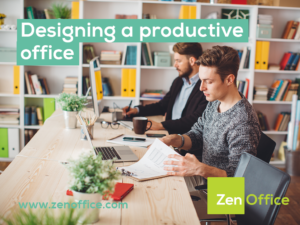
Where you work matters: An office can impact employees’ performance, mood and efficiency. If you’re cramped in a plain room with hard chairs and fluorescent lights, you probably won’t be as motivated as you would in an open space with large windows and private cubicles.
Creating different workspace environments within one office adds great flexibility. Having quiet areas, collaboration areas and sometimes even game areas can really help employees to perform at their best. It’s about having choice to work in a way that best suits the task on hand.
Here are five ways to create a workplace for your employees that’s designed for productivity.
Providing a place to escape office stressors is crucial to get the most from your employees. These spaces can serve many purposes, like lunch spots and informal meeting rooms. They can also be used to relieve eyestrain from staring at a screen or neck and back tension from sitting in one place.
Today, people really want space to relax at work. These spaces can come in all shapes and sizes but allow employees to feel more comfortable, express themselves and collaborate better with their peers at work.
Just as employees need a place to relax, they also need somewhere secluded to get work done.
Some employees handle disruptions better than others, but being in the middle of a hectic office can hinder performance and make employees feel more stressed. If a worker needs to focus on an assignment or even just take a personal call, they should have somewhere to go to do so.
In any office, having a variety of workspaces that are suited to different work styles and tasks is the key to ensuring that every employee can do his or her best work. Since individually owned workspaces are getting smaller with fewer boundaries, it’s crucial to make a series of interdependent spaces in an office ecosystem.
Even the simplest of advancements or changes in technology, like faster Wi-Fi or touchscreen tablets, are increasing demand for a more agile workplace.
Since people can work anywhere, it’s smart to provide a space that employees are happy coming to. You’ll want to offer the best technology your company can afford to retain talent.
The tough thing is finding the right balance. Each business is different, so it’s the job of the management to decide on what changes need to be made to the workspace to keep up with trend yet still meet the requirements of employees.
Employees spend a lot of time indoors. There’s a reason people tend to be happier when it’s bright and sunny rather than dreary and grey. If your office is a dull place with limited natural light, your workers might be snoozing by lunchtime.
According to a report by Cornell University’s Professor Alan Hedge, access to natural light increases alertness. In fact, workers in offices with smart glass reported a 56% decrease in drowsiness.
Lack of daylight and access to views decreases the ability for the eye to relax and recover from fatigue. Despite their best intentions, companies are unwittingly detracting from their employees’ health and performance by limiting their access to natural light.
The report found that employees with optimised daylight exposure experienced a 2% increase in productivity. To break it down, that is equivalent to an additional $100,000 per year for every 100 workers (equivalent to over £70,000).
Adding personality to your workspace can inspire and motivate you. Whether it’s a photo of your family or a poster of your favourite quote, any aesthetically pleasing art is good for the mind.
It’s proven that working in a space surrounded by artwork leads to an increase in creativity, not to mention, if you’re meeting with clients, it makes your space feel more welcoming and professional.
It’s recommended experimenting with pen and notepad organizers, peel-and-stick wallpaper for your desk, and even personalised mugs. Encourage your employees to do the same with their workspaces.
Info via Business News Daily, 2018